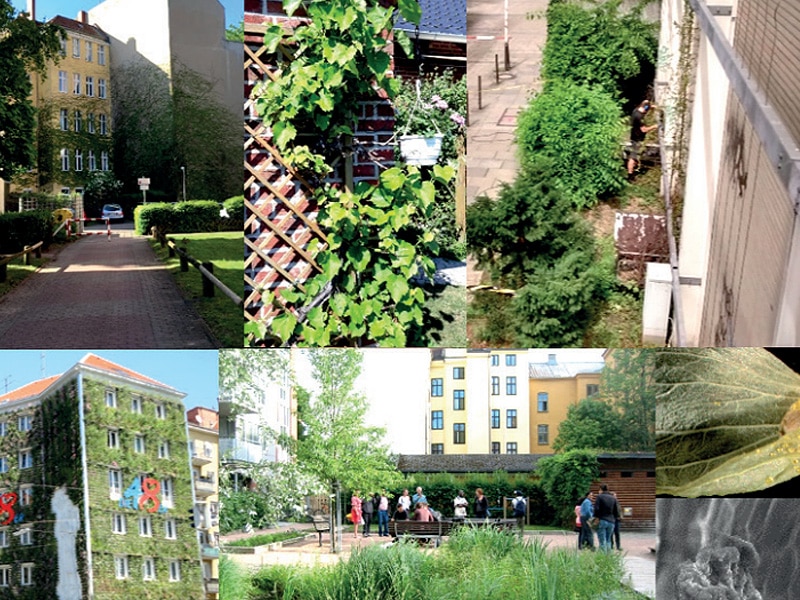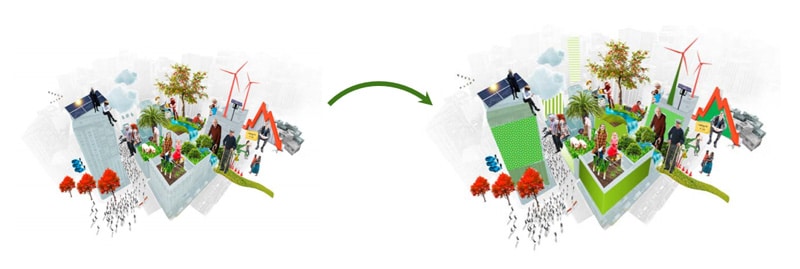Join JPI UE
Faq
FAQ
Please click here for the frequently asked questions we collected.
If you have an additional questions you are welcome to mail us at info@jpi-urbaneurope.eu

Vertical Greening is not a new concept, it was used in the paradisial Hanging Gardens of Babylon and has been covering buildings for centuries. Despite these long-standing examples, vertical greening is not very widespread in modern cities. This is about to change. According to the Vertical Green 2.0’s project coordinators Karin Hoffmann and Thomas Nehls, their new tools demonstrate that vertical greening, which can be a source for urban food, and at the same time an energy-passive cooling and thus an energy saving measure – for a wider range of buildings than previously expected…
Even newer and better insulated buildings greatly benefit from the energy saving impact of vertical greening.
The project has already produced two very useful tools that demonstrate the viability of vertical greening. One tool calculates what amount of cooling energy saving benefits can be gained with vertical greening. What is particularly striking, according to Hoffmann, is that the pre-existing literature had indicated that the buildings with the lowest insulation would be the ones that mostly benefit from vertical greening. However, in simulations with this tool, they found that even newer and better insulated buildings, such as prefabricated buildings from the fifties or insulated buildings, greatly benefit from the shading and the evapotranspiration cooling impact of vertical greening.
“The main finding from this work is that you really have to go into the specific building, the overall morphology of the buildings, the structure of its walls and its location to predict the impact”. Vertical Green 2.0’s tool will help policy makers with these complex calculations. The tool is available in an open-source environment and can be downloaded right away by a policy maker or planner. Nehls adds that the city of Hamburg is already using the tool.
Not only can vertical greening be a source for urban food production, but also a source of cooling for buildings.
Another key outcome of the project was the development of an adapted model that determines the water demand of vertical green. Nehls explains that this required taking the established method for calculating evapotranspiration, called ETo, normally used in (horizontal) agricultural contexts and adjusting measures for elements such as wind and solar radiation to consider vertical contexts.
This has led to the creation of the ETovert model, which can be used by policy makers and planners to calculate how much rainwater run-off and grey water (reusable domestic wastewater from showers, baths, washing machines etc.) can be upcycled by façade greening. The model has already been applied to compare the cities of Berlin, Copenhagen, Lisbon, Tel Aviv, Istanbul, and Rome to see how factors such as climate and architecture affect the water demands of façade greenery and what sources of water could be used (these results have been published in the open access journal Water).
When talking about the potentials of vertical greening to bring about urban transition, Hoffmann draws special attention to vertical greening’s capability to transform cities from linear systems, where water is drained away as fast as possible, to circular systems, where water is stored, used, managed for productive purposes and finally evaporated back into the atmosphere. Such water absorption for productive purposes is often difficult because in city centres the physical area for evapotranspiration (the sum of evaporation from land surfaces and transpiration from plants) is very limited. Façade greening mitigates this problem because it provides huge vertical surfaces where water can transpire with a small horizontal footprint.
This enables cities to transition towards more circular systems since surface runoff water and grey water are upcycled for plant growth and cooling
This enables cities to transition towards more circular systems since surface runoff water and grey water are upcycled for plant growth. In fact, the integration of vegetation into building surfaces in of itself is a transformation, it turns the buildings into what Nehls calls ‘multi-coded or multifunctional green(ed) infrastructure.’

One of the big questions Vertical Green 2.0 has helped to answer is why vertical greening has not been applied on a large scale before despite its promising nature. Nehls and Hoffmann say that their workshops with stakeholders have shown that there is a serious lack of knowledge amongst key stakeholders, such as municipal policy makers and city planners, about what vertical greening actually is. In fact, many stakeholders can think solely of ivy and its destructive qualities.
Thankfully, the work conducted in the project itself has contributed to demonstrating to stakeholders what vertical greening could be. The project has shown vertical greening can help create a nexus (a system which integrates food, energy, and water for efficiency and circularity) which generates new sources of food and energy. Nehls explains that the Berlin partners in the project planted four climbing plant species: one of these could be used as a bioenergy source and the other three (hops, grapevine, and beans) were actually food sources. Nehls highlights how the public are enthusiastic about such food sources although differently than expected: “Local people are already harvesting the leaves of the grapevine in spring.” Nehls and Hoffmann believe that this is just the beginning.
The project has shown that vertical greening can help create a nexus (a system which integrates food, energy, and water for efficiency and circularity)
Overall, the project has contributed to generating a large amount of data about the impacts of vertical greening, which is essential for the long-term prospects of vertical greening systems. Hoffmann: “Before this project, there was only limited short term data gathered under very specific meteorological conditions. We have provided solid data on a number of climbing plant species with varying water demands over several years and in a range of climatic conditions.”
Vertical Greening 2.0 has also started a living lab in the form of a demonstration follow-up project, which aims to show the public twelve different vertical greening systems. These systems will be installed in a well-visited area in Berlin and will be monitored and discussed with stakeholders in terms of their advantages, performance, and design. These different systems include ground based façade greenery, pot based greenery with different substrates, the wall-mounted so-called ‘living walls’, different sub straights but also experimental plans to install trees in front of the wall which will act as the trellises for the vertical greening.
In addition, the project has inspired a second project called “U-Green”, which builds on the findings of Vertical Greening 2.0. Hoffmann says “Vertical Greening 2.0 showed that there exists a lack of standardized methods for quantifying thermal behaviour of vertical greening systems as part of the building structure. U-Green will therefore address regulation in this area, both for vertical and roof top greenery.”
Read more about Vertical Green 2.0 here
This project is supported in the Sustainable Urbanisation Global Initiative (SUGI)/Food-Water-Energy Nexus, jointly established by the Belmont Forum and the JPI Urban Europe.
